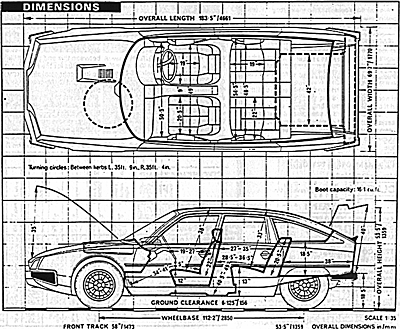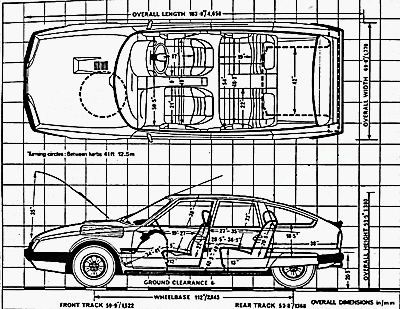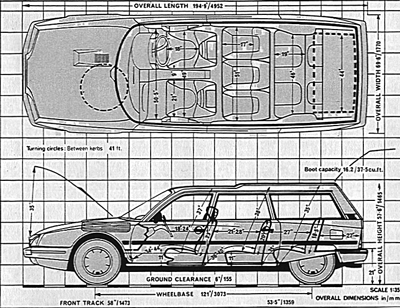 CX Series I
Saloon (Sedan)
CX Series I
Saloon (Sedan)
This FAQ aims to answer some of the common questions that arise on the CX mailing list. Please contact mailto:Alasdair.Mackintosh@eu.citrix.comwith any corrections or comments. Note that certain sections in square brackets [thus] indicate sections that are not complete.
This FAQ is Copyright (c) 1999 by the contributors. It may be freely reproduced in its entirety for any non-commercial application.
Disclaimer: This information is provided in good faith, in the hope that it will be useful. However, the authors cannot accept responsibility for any inaccuracies or errors, or for any damages that may arise from using this FAQ. If in doubt, please obtain professional advice.
Please read the safety notice in Section 4. NEVER crawl underneath a CX (or any CitroŽn with hydropneumatic suspension) unless it is properly supported. Do not rely on the suspension pressure to keep the car up. If the pressure falls, the car can descend quickly.
 CX Series I
Saloon (Sedan)
CX Series I
Saloon (Sedan)
 CX Series II
Saloon (Sedan)
CX Series II
Saloon (Sedan)
 CX Series I Familiale
(Estate)
CX Series I Familiale
(Estate)
The CX went through 3 main variants.
Body Styles
As well as the standard saloon (sedan), there are the following:
Engine Types
CX2400, CX25, CX GTi Original CitroŽn Overhead Valve push-rod engine, in 2.4 or (after 1984) 2.5 litre capacity. Very rugged and capable of high mileage. (300,000 miles is not uncommon.) Good performance, but fairly high fuel consumption.CX2400 has electronic fuel injection, CX25 adds fully electronic ignition. This is the only CX model available with automatic transmission.
(Early models had 2 or 2.2 liter versions of this engine, and some were equipped with a semi-automatic transmission called "C-Matic". This was discontinued in 1981.)
GTi Turbo/Turbo II Turbocharged version of CX25 GTi, with stiffer suspension and anti-roll bars. Turbo II has an intercooler, which improves economy.
CX20, CX22 More modern, all-aluminium Overhead Camshaft engine, also used by Renault, Peugeot and Volvo. (Sometimes referred to as "Douvrin" engine.) Available in 2 or (from MY85) 2.2 litres. Reliable and rugged, if not quite as long lived as the push-rod engines. All Douvrin engined CXs have carburetors, rather than EFI.
Diesel Original diesel has 75 hp, and was fairly slow. Turbo Diesel (TRD in Europe, DTR in UK) was introduced in 1984, with better performance and no loss in economy.
The OHV engines are very rugged, and more powerful than the OHC engines, but have worse fuel economy. The fuel injection & ignition systems are normally reliable, and need no adjustment, but they can suffer from electrical problems. (Although these are nearly always due to poor connections or wiring.)
The turbo diesels are excellent, and command higher resale values, but there can be problems with the engine blocks on the TRD 2. (NOT on the original TRD 1 or Diesel.) The blocks were made of recycled scrap steel, and the impurities in the metal can dissolve, allowing coolant to leak into the cylinders. Only solution is to replace the engine, or reline the cylinders. (Note that any TRD 2 with a reconditioned engine should be OK.) The problem can be avoided by using distilled water and a good quality antifreeze for the coolant. (Do not use tap water, which will help to dissolve the impurities in the block.)
The suspension should be very smooth. (See section 3.1 for causes of harsh suspension.) You may want to remove the front wheels to check that the suspension links and balljoint gaiters are OK. When doing this, also check the front disks. (Minimum thickness = 18mm.)
The steering should have a strong self-centering action, even when the car is stationary. There may be an occasional brief loss of power assistance during low-speed maneuvers (e.g. parking) but more serious losses indicate contaminated fluid or other steering problems.
Hold down the rear of the car. After 10 seconds or so, it should rise up again. Let go, and it will rise up. After another 10 seconds or so, it should sink down again. If it takes significantly longer, the height corrector is not working correctly. (Often caused by dirty hydraulic fluid.) Repeat the check with the front.
Check the rear brakes, especially on saloons. (The brake pressure is proportional to the load on the rear suspension, and if there is little load in the rear then the brakes get very little use, and can seize.) With your foot hard on the brake pedal, put the suspension on 'high'. The rear should stay down until you release the brakes, and should then shoot up.
Check that all electrical items work. Check that the heating and ventilation works correctly. (Access to the blower fan and heater matrix is difficult.)
Check for indications of poor maintenance and care.
See also: http://www.stack.nl/~cats/c_buygui.html
| Engine |
|
|
| CX25 (ohv) |
|
|
| CX20 (Douvrin) |
|
|
| GTI Turbo II |
|
|
| Turbo Diesel |
|
|
Revue Technique produce a manual (ISBN 2-7268-3955-X) for the CX20/22. (Note that this is in French.)
Revue Technique 96 rue de Paris, 92100 BOULOGNE-BILLANCOURT FranceThe official factory service manuals are the most detailed. These may still be availiable through CitroŽn dealers, or through CitroŽn Andre. (See below.)
CitroŽn have always recommended Michelin tyres, and these are the "safe" option. Some list members have recommended other tyres:
(Note: Normal size is 195/75. Some list members have fitted wider 205 or 215 section tyres.)
(Note: There are only two known manufacturers of this size of tyre.)
Andyspares (U.K.). Large parts supplier, with reasonable prices. Their website features a downloadable parts list. (http://www.andyspares.com/)The CitroŽn Connection website has a list of CitroŽn parts suppliers (including several in the USA). SeePleiades (U.K.) (+44) 1487 831239. Specialists in CitroŽn hydraulics. Sells a wide range of components, tools, flushing fluids, etc. Also in Australia (+61) ( 07) 4161-2512.
M&C Lockwood (U.K.) (+44) 1274 621840. General parts supplier. Low prices.
CitroŽn Andre (Netherlands). Independent CitroŽn experts. Parts (and cars) shipped worldwide. http://www.citroen-andre.com/
Western Hemispheres (USA) http://www.westernhemispheres.com/
Low sphere pressures will produce firm 'springs' with short suspension travel. A good test for this is to drive over a smooth obstacle such as a speed bump. If the car crashes over the bump, then the spheres need replacing or recharging. If the car drives smoothly over the bumps, but feels harsh when driving over small irregularities in the road, then check the suspension components.
Alternatively, try bouncing each corner of the car in turn. Short, firm travel indicates bad spheres. Any creaking noises suggest suspension wear.
Worn rear bearings may result in the suspension arms failing to align correctly. Check the rear tyres for any sign of uneven wear. Look carefully at the car from behind, and look for any signs that the rear wheels are not vertical. Alternatively, jack up the rear of the car, remove the wheels, put the suspension on 'low' and check for any free play in the suspension arm. Check that the rear anti-roll bar is tightly secured.
To check the front suspension, jack up the front of the car, remove the wheels, and put the suspension on 'low'. Check the balljoint gaiters - any splits mean that grease has leaked out, and the joint may be worn. Check upper and lower suspension arms for any free play at either end, using a long lever. Check anti-roll bar linkages.
A detailed schematic of the ABS system may be found here.
Alternatively, connect an audio amplifier on to the plug which comes from the
sensor (found under the bonnet). With the amplifier in the passenger
compartment, connected to the plug via a long screened, or twisted cable, listen
to the output whilst you drive down the road. (You may find that the amplifier
isn't necessary, and that the signal is strong enough on its own.) Do several
right and left turns, drive over humps, listening all the time. You should hear
an unbroken tone, varying in pitch in accordance with car speed. Any crackles or
sudden break ups suggest that it's the sensor and/or lead.
Safety Note:
Working on cars can be dangerous. Please don't undertake any task unless you feel confident in your abilities.
NEVER crawl underneath a CX (or any CitroŽn with hydropneumatic suspension) unless it is properly supported. Do not rely on the suspension pressure to keep the car up. If the pressure falls, the car can descend quickly.
A CX is best supported with axle stands underneath the four jacking points beneath the sills. (Make sure that there is no rust which could weaken these.) Alternatively, support the car beneath the horizontal tube that runs between and forward of the rear wheels, or beneath the point where the front suspension arms join the subframe. (The two longerons beneath the car, which look like chassis members, should not be used as jacking points.)
When raising one end of the car, it is often easier to put it on 'high', put axle-stands under the relevant jacking points, and then lower the suspension. Don't lower the car while it is supported by the wheel-changing jack, as you can easily twist the mounting points.
Before lowering the suspension, check carefully beneath the car. If one end is supported, make sure that the supports will be secure as the car lowers itself.
Note that the handbrake works on the front wheels. When raising the front of the car, make sure the rear wheels are securely chocked.
Never work on the hydraulic system (including spheres) without de-pressurizing it first.
http://www.fm.uit.no/~knutst/kes/cx/cx.htm http://hem2.passagen.se/bluestar/workshop.html
When replacing suspension spheres, try to crack them while the system is still pressurized. (This prevents the cylinders from twisting.) Then release all pressure and unscrew the sphere.
After the initial turn, the sphere should unscrew easily by hand. If you need to force it, then the system is still pressurized. Make sure that all pressure is released before continuing, or the sphere will fly out of its housing when it is finally unscrewed.
The rear spheres on a Break/Safari are very awkward. You will need to loosen the clip that holds the cylinder in place, and then slide the cylinder forwards to gain enough clearance.
If the car fails to rise after refilling the tank, you may need to prime the pump. Unclip the feed hose from the tank and slowly pour in LHM until it overflows. Reconnect the hose.
Bleed the brakes after changing the fluid.
If the old fluid was very dirty, consider flushing out the system with Hydraflush. (Available from CitroŽn dealers, or Pleiades.) Drain as normal, but refill with Hydraflush. After ~ 1000 miles, drain the flushing fluid and refill with clean LHM.
[Not complete]
All linkages in the mechanism must be free.See also http://hem2.passagen.se/bluestar/wkshp_hanbrk.htmlIf the outer sheath on the cables is cracked the cables will need replacing.
Check that the disks are not below the minimum thickness. (18 mm)